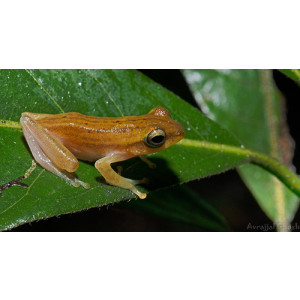Common Tree Frog Did you see this animal?
Scientific Name : Polypedates leucomystax
Family : Rhacophoridae
Order : Anura
Class : Amphibia
Phylum : Chordata
Other Name : Four- lined Tree Frog, White-lipped Tree Frog
Habitat : Almost every type of habitat, except salt water.
Description : Four-lined Tree Frog or White-lipped Tree Frog is a relatively small frog, with adults typically ranging from 2.5 to 4 cm in snout-vent length.
It is a brightly colored frog, with a green or brownish-green body that is marked with four distinctive, black stripes running along the length of its back. The frog also has a white or yellowish-white line running along its upper lip, giving it its common name of White-lipped Tree Frog. The underside of the frog is typically cream-colored or light brown, and the feet are equipped with adhesive pads that allow the frog to climb trees and other vertical surfaces.
The species is primarily arboreal and is often found in trees or other vegetation near water sources such as ponds, streams, and rice paddies. It is a nocturnal species, with most activity occurring at night.
The species is capable of laying large clutches of eggs, which are typically deposited on leaves or other vegetation above water sources.
It is known for its loud, distinctive call, which is often described as sounding like a loud, rattling snore. Males call from trees near water sources to attract females during the breeding season, which typically occurs during the rainy season.
It is a relatively active and agile species, and is known for its ability to jump long distances. It is also capable of changing color to some extent, with individuals becoming darker or lighter in response to changes in lighting conditions or temperature.
It is an insectivorous species, and feeds primarily on small invertebrates such as beetles, moths, and crickets. It is also known to occasionally consume small vertebrates such as other frogs or lizards.
It lays eggs. Males call from trees near water sources to attract females, and after mating, the female will deposit her eggs on leaves or other vegetation above the water. The eggs hatch into tadpoles, which drop into the water below and undergo metamorphosis into juvenile frogs.
It is capable of tolerate some level of pollution, although high levels of contamination can be harmful to the species. We should take necessary steps to protect them.
It is a brightly colored frog, with a green or brownish-green body that is marked with four distinctive, black stripes running along the length of its back. The frog also has a white or yellowish-white line running along its upper lip, giving it its common name of White-lipped Tree Frog. The underside of the frog is typically cream-colored or light brown, and the feet are equipped with adhesive pads that allow the frog to climb trees and other vertical surfaces.
The species is primarily arboreal and is often found in trees or other vegetation near water sources such as ponds, streams, and rice paddies. It is a nocturnal species, with most activity occurring at night.
The species is capable of laying large clutches of eggs, which are typically deposited on leaves or other vegetation above water sources.
It is known for its loud, distinctive call, which is often described as sounding like a loud, rattling snore. Males call from trees near water sources to attract females during the breeding season, which typically occurs during the rainy season.
It is a relatively active and agile species, and is known for its ability to jump long distances. It is also capable of changing color to some extent, with individuals becoming darker or lighter in response to changes in lighting conditions or temperature.
It is an insectivorous species, and feeds primarily on small invertebrates such as beetles, moths, and crickets. It is also known to occasionally consume small vertebrates such as other frogs or lizards.
It lays eggs. Males call from trees near water sources to attract females, and after mating, the female will deposit her eggs on leaves or other vegetation above the water. The eggs hatch into tadpoles, which drop into the water below and undergo metamorphosis into juvenile frogs.
It is capable of tolerate some level of pollution, although high levels of contamination can be harmful to the species. We should take necessary steps to protect them.
Distribution in Bangladesh
References:
description written by: Md. Shalauddin, Department of Zoology, Jagannath University, Dhaka. Information sources: IUCN Red List Bangladesh-2015, Hasan 2014, Khan 2018 (Photographic guide to the wildlife of Bangladesh).photo credit:wintang(www.inaturalist.org/people/wintang),photo copyright: iNaturalist. more information please contact with us.
description written by: Md. Shalauddin, Department of Zoology, Jagannath University, Dhaka. Information sources: IUCN Red List Bangladesh-2015, Hasan 2014, Khan 2018 (Photographic guide to the wildlife of Bangladesh).photo credit:wintang(www.inaturalist.org/people/wintang),photo copyright: iNaturalist. more information please contact with us.




















